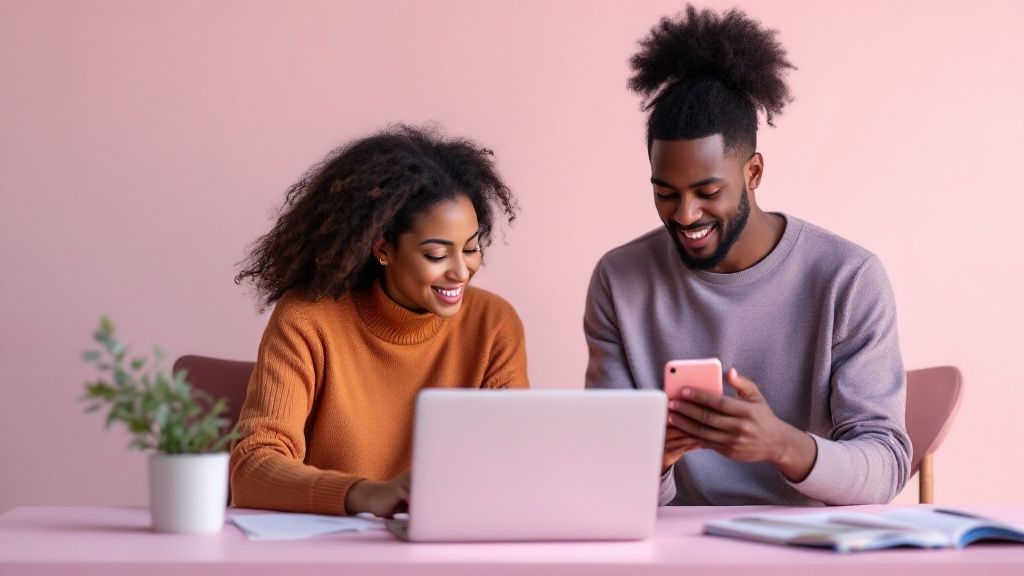Building Your Foundation For Sustainable Growth

Many bloggers concentrate solely on the writing process. They often overlook the essential groundwork required for steadily increasing blog traffic. This can be a recipe for frustration and stalled growth. To avoid these pitfalls, let's explore the key strategies successful bloggers use to cultivate a thriving online presence.
Understanding Your Audience Deeply
Driving consistent traffic to your blog hinges on a deep understanding of your target audience. This means going beyond simple demographics. Knowing your audience's age and location is a starting point, but it’s not enough. It won't tell you what truly motivates them. Instead, focus on understanding their pain points, content consumption habits, and decision-making triggers.
This means asking "why?" Why do they do what they do? What problems are they trying to solve? Where do they typically find and consume content online? What motivates them to take action, like subscribing to an email list or making a purchase?
Content Planning: Balancing Reader Interests and Search Intent
Once you have a good grasp of your audience, you can start planning content that resonates with them. At the same time, you need to align your content with what people are actively searching for online – this is called search intent. This balance is vital for boosting blog traffic.
Reader Interests: Create content that addresses your audience's needs and provides valuable solutions. This establishes you as a trusted resource, encouraging readers to come back for more.
Search Intent: Understand what people search for and create content that answers those queries. This improves your search engine rankings, driving organic traffic. You might be interested in: How to master content strategy.
Publishing Consistency Without Burnout
Creating a sustainable content calendar is essential for long-term growth. This involves balancing evergreen topics and trending opportunities.
Evergreen Content: Focus on creating timeless content that stays relevant and valuable for a long time. This draws consistent traffic over time.
Trending Topics: Include current trends and news to capitalize on short-term interest spikes. This can quickly increase traffic and attract new readers.
Also, set a realistic posting schedule. It's better to publish high-quality content regularly than to churn out subpar posts frequently. A well-structured content calendar can help you stay organized and maintain your momentum.
Leveraging Content Calendars for Long-Term Success
Successful bloggers use content calendars to plan their content strategically. This ensures a steady stream of valuable information. This proactive approach not only boosts traffic but also builds authority and brand recognition. A content calendar helps you map out both evergreen and trending content, maximizing your reach. For instance, scheduling evergreen content around key dates or holidays can significantly improve visibility.
Mastering Visual Content That Drives Engagement
Visual content isn't just window dressing; it's a vital tool for boosting blog traffic. It grabs attention, clarifies complex ideas, and encourages readers to share your content. This section dives into how strategically using visuals can transform your blog into an engaging hub that attracts and keeps readers coming back for more.
Choosing the Right Visuals
Different visuals serve different purposes. Mixing up visual formats caters to various learning styles and preferences. Think about incorporating:
- Custom Graphics: Infographics, charts, and visually appealing quotes can distill key takeaways and simplify dense information.
- Data Visualizations: Charts and graphs excel at presenting data-driven insights clearly and concisely. This boosts blog traffic by offering valuable, shareable content.
- Behind-the-Scenes Content: Photos and videos provide a peek into your process or company culture, building authenticity and connection with your audience.
- High-Quality Images: Relevant, high-resolution images break up text and make your blog visually appealing.
The infographic below visualizes keyword research data, illustrating the connection between average monthly search volume, keyword difficulty, and estimated click-through rate.

As the infographic shows, keywords with high search volume often come with higher difficulty. This means finding a sweet spot between targeting popular terms and selecting keywords you can realistically rank for. Picking keywords with a higher estimated click-through rate can also significantly increase blog traffic, even with moderate search volume.
Optimizing Images for SEO and User Experience
Optimizing images isn't just about making things look pretty; it’s crucial for SEO and user experience. Descriptive alt text helps search engines like Google understand the context of your images, improving your search rankings. Proper file naming and compression techniques improve load times without sacrificing image quality. Faster load times contribute to a better user experience, which can positively impact your search rankings and boost blog traffic. One of the most effective ways to increase blog traffic is by optimizing content with images. Studies show that blogs with relevant images receive 94% more views than those without. This underscores the importance of visual content in engaging readers and driving traffic. Furthermore, the trend toward using images in blog posts is supported by the fact that visual content is more shareable on social media platforms, which are used by 92% of bloggers to drive traffic. More detailed statistics can be found here.
To understand how visuals impact engagement, let's look at some data. The following table compares engagement metrics across different content types, both with and without images.
Visual Content Performance Comparison
Comparison of blog engagement metrics with and without visual content across different content types
| Content Type | With Images | Without Images | Improvement Rate |
|---|---|---|---|
| Blog Posts | 1000 views | 500 views | 100% |
| Articles | 750 views | 350 views | 114% |
| Case Studies | 600 views | 250 views | 140% |
As this data illustrates, incorporating visuals significantly increases views across all content types. This reinforces the idea that visual content plays a crucial role in attracting and engaging readers.
Creating Visual Content Series
A consistent visual style strengthens your brand identity and increases recognition. Consider creating visual content series aligned with your blog's overall theme. This could involve regularly posting infographics, creating a consistent style for featured images, or developing a series of behind-the-scenes videos. This consistency helps establish your brand and encourages readers to return for more.
Budget-Friendly Visual Creation Tools
Creating professional-looking visuals doesn't have to be expensive. Many free and affordable tools are available online. These tools help you create custom graphics, edit photos, design infographics, and produce engaging videos. This empowers bloggers at all levels to enhance their content with high-quality visuals. Mastering visual content is essential for increasing blog traffic. By incorporating a variety of visuals, optimizing them for SEO, and developing a consistent visual strategy, you can transform your blog into a dynamic and engaging platform that attracts and retains readers.
Leveraging Social Media For Maximum Blog Traffic
Social media is more than just casually posting links and hoping for a surge of traffic. It's a dynamic tool for cultivating a loyal readership through authentic engagement and strategic content distribution. This means understanding the individual strengths of each platform and adapting your approach accordingly.
Platform-Specific Strategies
Every social media platform offers unique advantages for directing traffic to your blog. LinkedIn excels at professional networking and sharing industry-specific insights, making it perfect for connecting with a professional audience. Meanwhile, Instagram thrives on visual storytelling, making it ideal for sharing eye-catching content that grabs attention and fosters engagement. Understanding these nuances is crucial for maximizing your impact and reach.
Creating Compelling Social Media Teasers
A well-crafted teaser piques interest without giving everything away. Think of it as a movie trailer that entices viewers without revealing the entire plot. Offer a glimpse into your blog post's key takeaways. Pose a thought-provoking question, or share a surprising statistic to encourage clicks and drive traffic.
Timing and Hashtag Strategies
Timing is critical on social media. Posting when your audience is most active significantly boosts visibility and engagement. Additionally, strategic hashtag research can dramatically amplify your organic reach. Hashtags act like keywords for social media, connecting your content with a broader audience interested in your niche.
Cross-Platform Promotion and Community Engagement
Promoting your blog across various social media channels broadens your audience and increases visibility. This can be as straightforward as sharing a link to your latest post on all your profiles. Active community engagement is also vital for building relationships and fostering loyalty. Responding to comments, participating in discussions, and sharing user-generated content strengthens your online community and, in turn, increases blog traffic.
Social media's role in driving blog traffic is undeniable. Approximately 92% of bloggers utilize social media to boost their blog's visibility and reach a wider audience. This is largely due to the extensive reach and diverse promotional tools these platforms provide. Find more detailed statistics here.
Leveraging User-Generated Content
User-generated content (UGC) is a potent tool for boosting blog traffic. It's essentially word-of-mouth marketing amplified. Encouraging your audience to create and share content related to your blog significantly expands your reach and builds trust. Consider running contests, showcasing user-submitted photos or videos, or re-sharing positive reviews and testimonials. Read also: How to monetize a newsletter. Leveraging UGC increases visibility and cultivates a sense of community, ultimately strengthening your brand.
SEO Strategies That Actually Drive Traffic

Driving traffic to your blog takes more than just good writing. It requires ensuring your content is easily found. This means using effective Search Engine Optimization (SEO) strategies that work with how search engines and users operate.
Keyword Research: Uncovering Hidden Opportunities
Effective SEO starts with thorough keyword research. This means finding the terms your audience uses when looking for information related to your niche. But it's not about finding any keyword.
It's about finding low-competition, high-value keywords your competitors might have missed. Think of it as searching for hidden gems. This is where keyword research tools like Semrush become invaluable.
On-Page Optimization: Making Your Content Shine
After finding your keywords, it's time to optimize your content. On-page optimization refers to everything you can do on your website to improve its search engine rankings. This includes carefully crafting title tags and meta descriptions that accurately reflect your content and make people want to click.
For example, "Blog Post" is a weak title tag. "Increase Blog Traffic: 7 Proven Strategies" is much better. Also, internal linking, like linking to another helpful article on your site, helps users and search engines navigate your blog. For example, you could link to a related article on how to make money blogging: How to make money blogging online as a solo blogger. These small changes can make a big difference.
Semantic SEO and Featured Snippet Optimization: Going Beyond Keywords
Good SEO is more than just using keywords. Semantic SEO focuses on understanding what a user wants from a search and giving complete answers. This involves using related keywords and phrases to create content that truly helps the user.
Another great strategy is optimizing for featured snippets. These are the concise answers at the top of search results. Featured snippets can greatly increase traffic by putting your content directly in front of users.
Technical SEO: The Foundation of a Healthy Blog
If your website has technical issues, your SEO efforts are wasted. Technical SEO is about optimizing the backend of your blog for better performance.
This means improving loading speed, making sure your site works well on mobile devices, and creating a sitemap. These things significantly impact both your search rankings and user experience.
Measuring Your Success: Tracking Your Progress
SEO is an ongoing process. You need to track your progress and adjust as needed. Monitor your keyword rankings, analyze your website traffic, and watch user engagement.
Social media is a powerful tool to boost blog traffic. Learn more about leveraging social media for your blog. Blogs using comprehensive SEO strategies see an average traffic increase of 434% in 12 months, with 67% of successful bloggers reporting organic search as their main traffic source. Learn more about these statistics here. By understanding your audience and using these SEO techniques, you can create content that ranks well and truly connects with your readers.
Building Authority Through Strategic Content Marketing

Establishing your blog as the ultimate go-to resource requires more than just frequent posting. It demands a strategic approach to content marketing that cements your status as a thought leader. This involves crafting content that not only attracts readers but also showcases your deep expertise in your chosen niche.
Creating Pillar Content That Attracts Backlinks
One of the most effective strategies to boost blog traffic and build authority is through the creation of pillar content. Think of these pieces as foundational cornerstones, providing in-depth explorations of core topics within your niche. These comprehensive articles act as central hubs, naturally attracting backlinks from other websites seeking credible and authoritative sources.
For instance, if your blog focuses on digital marketing, a pillar piece might be titled "The Ultimate Guide to Content Marketing Strategy." This kind of in-depth content establishes you as a subject matter expert, leading to increased visibility and organic traffic. Plus, pillar content creates a framework for related, shorter blog posts, further enhancing your topical authority.
Guest Posting For Quality Referral Traffic
Guest posting on relevant blogs offers another powerful way to grow blog traffic and build authority. By contributing valuable insights to established platforms in your niche, you showcase your expertise to a broader audience. The key here is to prioritize quality over quantity. Focus on reputable blogs with engaged readerships that align with your target demographic.
This targeted approach directs highly qualified referral traffic back to your blog. Furthermore, guest posting opens doors to valuable backlink opportunities, which strengthens your SEO performance and elevates your blog's authority in the eyes of search engines like Google.
Collaboration and Shareable Resources
Collaborating with other bloggers and influencers within your niche expands your reach and introduces you to new audiences. Joint webinars, co-created ebooks, or even simple social media shout-outs can significantly amplify your blog traffic. This cross-promotion exposes your blog to a wider network of potential readers.
Moreover, developing shareable resources like infographics, templates, or checklists provides valuable assets that others naturally want to reference and link back to. For example, check out this guide on content marketing strategy templates. Looking to boost your blog traffic further? Consider the expert advice on how to optimize YouTube videos. This type of valuable content naturally attracts backlinks and positions your blog as an indispensable resource.
Email Marketing and Community Building
Integrating your blog with email marketing lets you nurture your audience and drive repeat traffic. Offering valuable content upgrades or exclusive insights in exchange for email sign-ups helps you build a loyal following. This consistent engagement keeps your blog at the forefront of their minds and encourages readers to return for more valuable information.
Cultivating a strong community around your blog further elevates user engagement and loyalty. Actively responding to comments, hosting Q&A sessions, and creating opportunities for reader interaction foster a sense of belonging. This strengthens your brand and encourages readers to actively share and promote your content. A vibrant community transforms one-time visitors into dedicated followers invested in your blog’s continued success.
The following table showcases the effectiveness of various content marketing strategies in driving blog traffic and building authority.
Content Marketing Strategy Effectiveness
| Strategy | Traffic Increase | Authority Score | Implementation Difficulty |
|---|---|---|---|
| Pillar Content | High | High | Medium |
| Guest Posting | Medium | High | Medium |
| Collaboration | Medium | Medium | Low |
| Shareable Resources | High | Medium | Medium |
| Email Marketing | Medium | Low | Easy |
| Community Building | Low | High | Medium |
This table summarizes the potential impact of different approaches, considering both their potential to drive traffic and enhance authority, along with their relative ease of implementation. As you can see, a balanced approach leveraging multiple strategies is likely to yield the best overall results.
Converting Visitors Into Loyal Blog Readers
Attracting visitors to your blog is a great accomplishment, but it's only the beginning. The true measure of success lies in turning those first-time visitors into loyal, returning readers. This section explores proven strategies to build a dedicated community around your blog, transforming casual browsers into active participants and enthusiastic advocates.
Enhancing User Experience for Deeper Engagement
A positive user experience is crucial for encouraging visitors to explore your blog. This includes everything from easy navigation and fast loading speeds to content that's easy to read and understand. Think of a physical store with a confusing layout and slow service – you’d probably leave quickly. Similarly, a poorly designed website with slow loading times and a confusing interface will discourage visitors, no matter how good the content is. A one-second delay in page load time can lead to an 11% decrease in page views.
To improve user experience, focus on these key areas:
Intuitive Navigation: Make sure your blog’s layout is user-friendly. Readers should easily find what they’re looking for. A clear menu structure and internal links are essential.
Optimized Loading Speeds: A fast-loading blog keeps readers engaged. Compress images, optimize your website's code, and choose a reliable hosting provider. For more information, check out this guide on how to start a blog.
Content Formatting: Break up large chunks of text with headings, subheadings, bullet points, and visuals. This makes your content more digestible and encourages readers to stay longer.
Building Your Email List and Offering Valuable Content Upgrades
Building an email list is essential for any successful blog. It lets you connect directly with your audience, share new content, and build relationships. However, avoid being overly aggressive. Offer something valuable in exchange for their email address.
Content upgrades are a great way to encourage sign-ups. These are valuable resources related to your blog posts, like checklists, templates, or ebooks, offered exclusively to subscribers. This targeted approach ensures you deliver relevant and helpful information to engaged readers.
Fostering Meaningful Discussions in the Comment Section
An active comment section transforms your blog from a static platform into a dynamic community hub. Encourage discussions by responding thoughtfully to comments and creating a welcoming space for diverse perspectives. This builds a sense of community and encourages readers to return and participate.
Advanced Retention Techniques: Personalization and Loyalty Programs
As your blog grows, consider more advanced retention strategies. Personalization, like recommending content based on reader behavior, creates a more tailored experience. This shows readers you understand their interests, strengthening their connection to your blog.
Loyalty programs are another powerful tool. Rewarding loyal readers with exclusive content, early access to new posts, or even discounts can foster a sense of appreciation and encourage long-term engagement.
By implementing these strategies, you'll not only increase blog traffic but also cultivate a thriving community of dedicated readers who actively contribute to your blog’s success.
Key Takeaways
Building measurable blog traffic isn't something that just happens. It takes a well-defined plan with actionable steps, realistic timelines, and built-in ways to measure your progress. This section provides the framework and timelines you need to turn insights into immediate wins and build long-term growth.
Strategic Action Plan Overview
To boost your blog's traffic, divide your strategy into focused phases: foundation, engagement, promotion, and retention. Start with the basics, like setting up analytics (Google Analytics), and then gradually add visual elements and social media engagement. This phased approach helps you avoid feeling overwhelmed and maintain momentum.
Monthly Checklists
- Month 1: Analytics Setup, Audience Goals, Content Pillars
- Month 2: Visual Branding, Infographic Creation, Image SEO
- Month 3: Social Teasers, Posting Cadence, Hashtag Research
- Month 4: On-Page SEO, Internal Linking, Keyword Expansion
- Month 5: Guest Outreach, Backlink Campaigns, Collaboration
- Month 6: Email Series, Content Upgrades, Community Engagement
Each item represents a focused activity you can tackle in a dedicated sprint to ensure steady progress.
Priority Framework and Timeline
A simple table can help align your strategy, key metrics, and expected timeframes. Visualizing your progress keeps you motivated and on track.
| Strategy Phase | Key Metric | Expected Timeline |
|---|---|---|
| Analytics & Goals | Traffic Baseline | 1–2 weeks |
| Visual & UX Enhancements | Bounce Rate ↓ by 15% | 3–4 weeks |
| Social Media Promotion | Social Referrals ↑ by 20% | 5–8 weeks |
| SEO & Content Expansion | Organic Visits ↑ by 30% | 9–12 weeks |
| Authority Building | Backlinks ↑ by 25% | 13–16 weeks |
| Retention & Community | Email CTR ↑ by 10% | 17–20 weeks |
This framework balances quick wins like image optimization with long-term growth strategies like guest posting.
Tracking Progress and Troubleshooting
Effective measurement helps identify problems early and capitalize on what’s working. A dip in traffic after a new update often signals a technical issue or a disconnect between your content and your audience.
Best Practices for Measurement:
- Use Google Analytics Goals to track subscriptions, downloads, or page views.
- Monitor page speed and mobile usability in Google Search Console.
- Review social share counts and comments weekly to gauge engagement.
Quick Troubleshooting Tips:
- If sessions drop suddenly, check for broken links or server errors.
- A spike in bounce rate often indicates a need to improve content formatting.
- Low email click-through rates can be addressed by refining subject lines and segmenting your email lists.
By combining clear priorities, a structured timeline, and precise measurement, you’ll steadily increase your blog traffic.
SEO–ready, Analytics, No–code.
Your Content Publishing Engine
Deliver your SEO–driven content!
Visit BlogMaker.app



